Most people associate pickled ginger with Japanese sushi but it’s prepared and enjoyed in other parts of Asia. Years ago thumbing through a classic Vietnamese cookbook from the 1940s, I came across a pickled ginger recipe that was similar to the Japanese preparation but less sweet. Here’s a Thai recipe that is more tart than sweet and another that’s fancied up with lemongrass and chile (reminds me of the green tomato pickle I make).
But the Japanese version (gari) is without doubt the go-to. The commercial gari pales in comparison to homemade, which has brighter flavor and personality. Plus you can tweak the brine according to your taste.
The first task is getting the ginger! Typically cooks use young ginger that’s mild in heat and easy to slice. Its skin is translucent so it looks creamy. Sometimes there are pink pointy tips, too. I used to see young ginger at Asian markets in September but recently, I spotted some at Mitsuwa, a Japanese market with locations in major Asian enclaves; check other Japanese and Chinese markets. The summer ginger seemed to be a little tougher (more heat).
The young ginger was about $8 a pound but I only needed about half a pound for exceptional pickled ginger that I’ll keep around for a long time.
I’ve eaten raw young ginger with Thai sausage and stir-fried with young ginger (no peeling and there’s a sweeter kind of heat). But in the main, I pickle it to make the most of my investment. I’ve pickled whole knobs but that takes a while to mature.
Slicing the ginger is best done with a mandoline or super sharp knife. I actually use both. The mandoline does most of the work and my knife (a Japanese nakiri vegetable knife) finishes the pieces that are too dangerously small to put through the mandoline.
I currently have a Kyocera mandoline slicer with great ceramic blade, but it can slip easily so I set it inside a container like this glass one. I just saw this affordable OXO mandoline slicer that supposedly is non-slip. (If you’ve used the OXO, let me know your thoughts!)
Can’t find young ginger to pickle? Use “old” ginger -- the kind sold at supermarkets with tan skin. Pick knobs that are juicy and mild tasting. Scrape the ends with a fingernail to taste it. Peel it with a spoon or vegetable peeler before slicing. To reduce harshness, soak the ginger several times in just-boiled water for 1 to 2 minutes, changing the water in between soakings. I’d soak 2 to 4 times, depending on the heat of the ginger. You want some but not a ton of heat!
Transferring the ginger to a pickling container is easily done with a canning funnel. I have a plastic one similar to this one that works like a charm for many kitchen tasks!
A few years back I posted a recipe for Japanese pickled ginger from the Asian Pickles cookbook, but it was on the sweet side. For this recipe, I cut back on the sugar and increased the vinegar. I also used organic cane sugar, which has an interesting round mouthfeel and is sweeter than regular white sugar. You can try ¼ cup of sugar, if you want to cut down on sweetness even more. You can always add a little extra sugar to the brine after you’ve cooked and tasted it.
For the rice vinegar, my go to brands are Japanese, such as Marukan brand. Instead of blanching the ginger as some recipes call for, I soak it in just-boiled water from an electric kettle, on of my favorite kitchen appliances. It's less fussy.
What to do with all that pickled ginger that you’ll soon have in the fridge? Aside from the usual use for pickled ginger -- as a side for sushi, cook with it. Try this Chinese panfried tofu with pickled ginger recipe.
Japanese Pickled Ginger (Gari)
Yield 1 ½ cups
Ingredients
- 9 to 10 ounces young ginger
- ⅓ cup plus 1 ½ tablespoons sugar, organic preferred for great flavor
- 2 teaspoons fine sea salt, or 1 ½ tablespoons kosher salt
- ⅔ cup unseasoned Japanese rice vinegar
- 2 squares of dried kombu (kelp), each about the size of your thumbnail (optional)
Instructions
- Use an inverted spoon to scrape off the thin, papery bits from the ginger. To cut super thin slices, use a mandoline or very sharp knife. Cut across the grain and aim for nearly see-through pieces.
- Transfer the ginger to a saucepan or heatproof bowl. Toss with the 1 ½ tablespoons of sugar and salt. Set aside for 30 minutes to reduce its harshness.
- About 10 minutes before the ginger finishes mellowing out, bring a kettle of water to a boil. When the ginger is done, pour the just-boiled water over the ginger. Use enough water to cover the ginger. Gently stir and let sit for 20 seconds to further reduce the harshness. Dump into a mesh strainer. Don’t rinse. Shake a few times to expel water, then transfer into a 2-cup capacity glass jar.
- In a saucepan (it's fine to reuse the one you just used!), bring the mixture of sugar, vinegar, and kelp to a boil. Stir once or twice to dissolve the sugar. Remove from the heat and pour into the jar of ginger.
- Push down with chopsticks or a spoon to submerge. Cool, uncovered, then cap and refrigerate. Depending on the ginger, it may be ready to eat in 1 to 3 days. Taste and see. Keeps well in the refrigerator for 6 months.













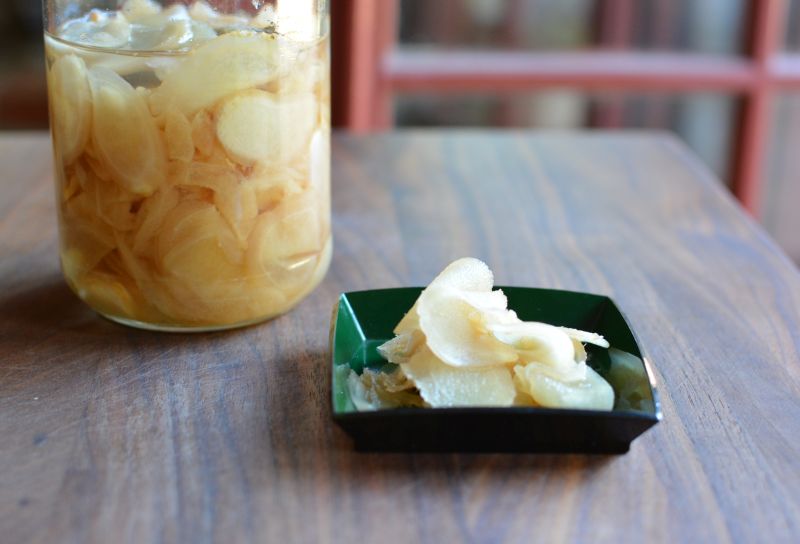
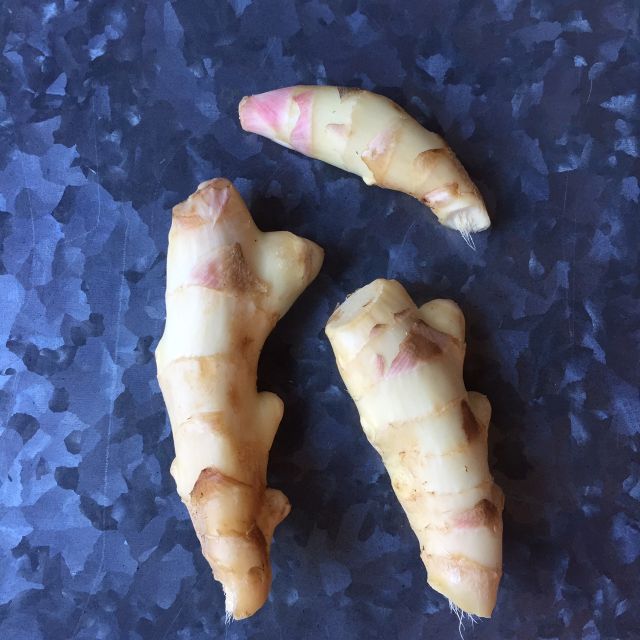
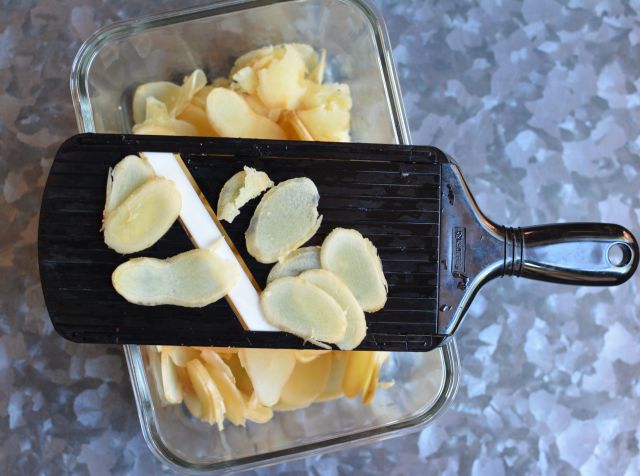
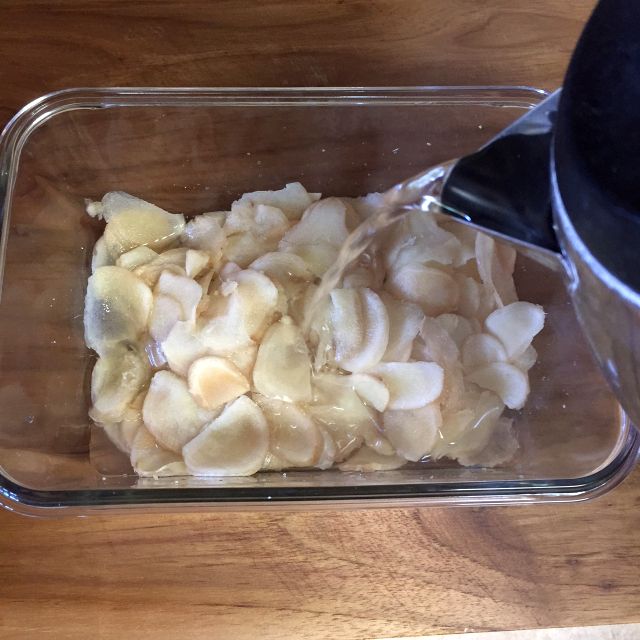
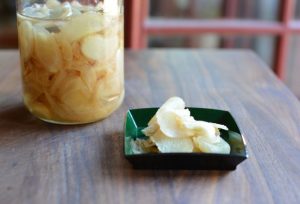




Dan says
Hi, I didn't know it was so simple to make this pickle. Must try!
I have that Oxo mandoline as one of three. It's nonslip because one side of it (when held at an angle) has a rubbery material. It's good and inexpensive. In comparison, I have a Japanese slicer that fits on top of a plastic box (slips all over the place but keeps slices tidy), and an old-school Bron brand with adjustable cutting width. Expensive, had to save money to buy it!
Billy says
This looks great! I love ginger, but you're right when you say the only time i've ever really had it was with sushi! I really want to try this at home, I think it would be a great snack to have every now and then. Thank you for sharing!
Andrea Nguyen says
Make some and share your feedback. I'm sure Bubbies has nothing like it!
Andrea Nguyen says
You're a slicer expert and collector. Yowza.
Peter Atrens says
I just use a vegetable peeler but instead of chips i make slices along the root.
steph says
I have the OXO mandoline with 4 different blades that slice into a provided container with a non-slip base. I use it for bushels of pears and apples from my trees, cucumbers, ginger, etc. It works great aside from the container filling quickly and there is no way to adjust thickness of the slice.
Andrea Nguyen says
Nice to know about the OXO mandoline! I've wondered about it so it's great to have your feedback, Steph. Thank you for sharing your experience.
Mary Bess says
I can not find a slicer that makes paper-thin slices of ginger for pickled ginger to accompany sushi. I have an adjustable mandolin that doesn't do the job, neither does a hand-held vegetable peeler. I have tried a Japanese grocery store,but nothing there looks like it would produce the thin slices I need.
Any suggestions?
Andrea Nguyen says
I use a ceramic mandolin like this one and it's been with me for over 5 years. Hope that helps in your quest.
https://amzn.to/2YlvyCC
Danny says
So far so good. This is my first time trying. I adjusted a slight bit in some places just to see how 'I' will like slightly less, but overall I have used the same recipe today. I took a quick nibble of a piece after prepared and it seemed fine without having anything really soak or soften more just yet, but I will be testing over the next couple of days and would much prefer to do my own pickled ginger than storebought with leftovers from ginger tea/ale.
Andrea Nguyen says
Homemade food rocks. Pickled ginger is so simple and it keeps for a very long time. I have a well aged jar in the back of my fridge. Hope you enjoy it!
Andrea says
Great recipe. I use a vegetable peeler to slice the ginger. Makes perfect paper thin slices.
Andrea Nguyen says
You love the veggie peeler too? OMG -- it's my little secret tool for so many tasks. Thanks for the tip!